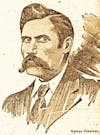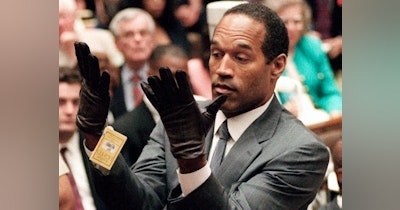On the fourteenth of December 1865, a Polish carpenter and his wife welcomed their new son into the world. Seweryn Klosowski entered into a life of opportunity. Instead of apprenticing with his father and becoming a carpenter, as was commonly done in Poland in those days, Seweryn apprenticed with a surgeon. The boy was still young and he didn’t take part in any major surgeries or practices that doctors would be trained in today, but Seweryn learnt how to apply leeches and perform blood lettings.
And apparently he was pretty good at it.
His Master, Moshko Rappaport, said that Seweryn was “diligent.” He always had “exemplary conduct and studied with zeal the science of surgery.” Another source said that Seweryn was “very skilful assistance to patients.”
So it was perhaps no surprise when Seweryn enrolled in the studies of practical surgery at the Warsaw Praga Hospital, but perhaps was what a surprise was how long Seweryn actually stayed there. Seweryn only studied for three months before he dropped out. He stayed on another year at the hospital, working as a nurse and sometimes a doctor’s assistant, but it looked like Seweryn’s medical career had come to an abrupt end.
Shortly after, he moved to London in the United Kingdom, where he settled in the East End and became a hairdresser’s assistant. It looked like Seweryn had officially swapped the scalpel for the scissors.
He was apparently good enough to open up his own barbershop within about a year of moving to London. It’s difficult to say how long it took him for sure as his entry date into the UK is a little bit of a mystery, but it’s safe to say that he was living, working and running his own establishment in London by 1889. The shop was located in Cable Street, St George in the East, a name that Seweryn would adopt to make living in the UK easier.
Now going by George, Seweryn married a young Polish woman named Lucie Badewski. The pair of them had met at the Polish Club in St John’s Square only five weeks before the wedding, but it looked like George had swept poor Lucie off her feet.
Within months, there was a knock on the young couple’s door and Lucie was confronted with an unexpected truth. It turned out that George was already married. His first wife had stayed behind in Poland when George had emigrated to London, but there she was and she wanted her husband back.
Almost unbelievably, George managed to twist the situation to his benefit. He then had both of his wives living with him under the same roof in London, possibly both vying for his attention and competing with each other, but that all changed less than a year later. In September 1890, Lucie and George welcomed a son into their lives and George’s first wife moved out.
George and Lucie were now official, if still only unofficially married. In 1891, they upheaved everything and moved to America, where George found work in another barbershop in New Jersey.
Things seemed to go well at first, but over the short years of their marriage something had changed in George and it didn’t look like things would be getting any better. George had turned violent and the person who bore the brunt of his furious outbursts was his wife Lucie.
He beat her often and cruelly, but Lucie later told of the beating that ended everything. According to her later statement, in February 1892, George dragged Lucie into their bedroom and threw her onto the bed. He then began to strangle her, ignoring how she fought back and the fact that she was pregnant at the time. He only stopped when he heard a customer entering the shop that was adjoined to their room and left Lucie gasping for breath on the bed. It was then that Lucie spotted the handle of a knife poking out from under his pillow and she knew that things could have potentially gotten a lot worse.
She hid the knife and when she later confronted George about it, he admitted that he’d planned on killing her. He’d hidden the knife under the pillow because he’d planned on decapitating her and he even showed her where he was going to hide her body afterwards. Lucie called his bluff and claimed that he wouldn’t have gotten away with it, especially because the neighbors would have noticed if she’d disappeared.
“Oh,” Lucie later recalled George saying. “I should simply have told them that you had gone back to New York.”
Lucie didn’t take her chances and moved back to London to live with her sister. Shortly after the birth of their daughter, George returned to his wife, but it was clear that the marriage was over.
George moved out and found work in another barbershop to keep himself afloat. Their son had, unfortunately, died of pneumonia while George and Lucie had been living in the States, but George cut ties with Lucie and his newborn daughter and never sent them any financial support from the wages he earned from his new job.
Instead, he met a woman named Annie Chapman and a familiar story played out. George swept Annie off her feet and within weeks they had struck up a relationship and moved in together. George took Annie’s last name and George Chapman became his new identity, covering his tracks and hiding the life he’d just left behind.
Only a year later, George brought another woman to live with him and the then pregnant Annie, possibly thinking that he could have his cake and eat it too just like he had with Lucie and his first wife from Poland. It took Annie only a few weeks before she drew the line in the sand and moved out. When she later told George about their newborn child, George cut ties with them and moved on just like he had before.
George then found Mary Isabelle Spink through his workplace and he smelled opportunity. Mary had a bit of money stashed away and she was on a bit of a downward spiral. She was an alcoholic and her husband had just left her and taken their son with him. George then stepped up to try to heal Mary’s broken heart.
The pair of them first opened up their own unsuccessful barbershop in a poor area of town before picking up shop and moving to a wealthy area. There Mary played the piano while George cut hair and what would become known as their “musical shavings” was a massive hit. Business boomed for a while, but like any fad, it also died out.
George had to take to managing a local bar to keep afloat and Mary bore the brunt of his temper. A neighbor later told of often hearing Mary crying out in the nights and she would see the marks and bruises on Mary’s body the following day. This was the routine until poor Mary fell ill.
After that, George took to looking after his wife, dutifully preparing her medicine for her and doing everything he could to get her well again. Within months, Mary was dead. She’d suffered from terrible cramps in her stomach, vomiting and diarrhea until her body had simply given up. A friend who’d later helped prepare Mary’s body for burial described it as “a mere skeleton.”
Witnesses said that when she had died, George had stood over Mary’s body and said: “Polly, Polly speak!” before going into the room next door and crying. He then went downstairs and opened the pub even though he was now a rich man. Mary left her unofficial husband 500 GBP, or what would be over 60,000 GBP in today’s money, and George put it to good use.
He hired Bessie Taylor to be the new manager, but it wasn’t long before Bessie was a little bit more than just an employee. Bessie took Mary’s place and George soon turned violent. George not only beat her, but once reportedly threatened her with a revolver and then Bessie was suddenly struck by the same mysterious illness that had killed Mary.
To avoid scandal, George first moved Bessie away to Hertfordshire, where she underwent surgery, but nothing seemed to be getting Bessie better. Eventually, he moved them back to London, where Bessie’s condition just grew worse and worse.
A friend made a point of visiting Bessie everyday and everyday was a new opportunity for George to get his thrill. More than once, George would answer the door and tell Bessie’s friend that Bessie had died during the night. Her friend would then race up the stairs only to find Bessie still sick but still alive. One time, George told her that everything was fine and Bessie was just the same as she’d been the day before. It was that time that Bessie’s friend went in only to find out that Bessie had actually died the day before.
George moved on. He hired a new barmaid and a now all too familiar story played out. The new couple wed in an unofficial ceremony, because George was still married to his first wife in Poland, and George turned violent.
And then George’s new wife, Maud Marsh, became sick. Thinking that her new son-in-law was a little too keen about preparing her daughter’s medicine. Maud’s mother intervened. She took over control of administering Maud’s medicine and called an independent doctor to examine her daughter.
Probably feeling trapped, George then gave Maud a massive dose of his “medicine” and she died the very next day. Maud’s death sparked suspicion and also cast suspicions on the deaths of George’s previous unofficial wives. Before long, the authorities had exhumed both of their bodies and discovered that all three women had actually been poisoned.
George was arrested and taken to trial where he was found guilty of murdering Maud. The sentence was death by hanging, a sentence that was carried out only weeks after George Chapman was found guilty. His motives for committing his heinous crimes still remain a mystery. Mary was the only death that seemed to directly benefit him, at least financially. The other two women had nothing and left him nothing, but it is speculated that George had even more unsavory reasons for committing these murders.
When George was arrested, inspectors at the station commented that the infamous Jack the Ripper had finally been caught. George did fit the profile. He matched the witness’ description of a man with a thick, dark mustache and he also somewhat fit the witness testimonies of a man with a Russian accent.
George spent most of his time in London either living directly inside or around White Chapel where most of Jack the Ripper’s killings took place. He even had a background in surgery which could fit the theory of Jack the Ripper’s supposed experience with scalpels and anatomy. Lucie later testified that George would disappear for hours at a time during the nights, but all of this is circumstantial at best.
There is no concrete evidence that George Chapman was actually Jack the Ripper, in fact most modern theorists place him very low on the list of possible suspects. We do, however, know that he poisoned three women to death and tried to cover his tracks, but we possibly will never know if he was capable of and did commit even more heinous crimes than that.

















